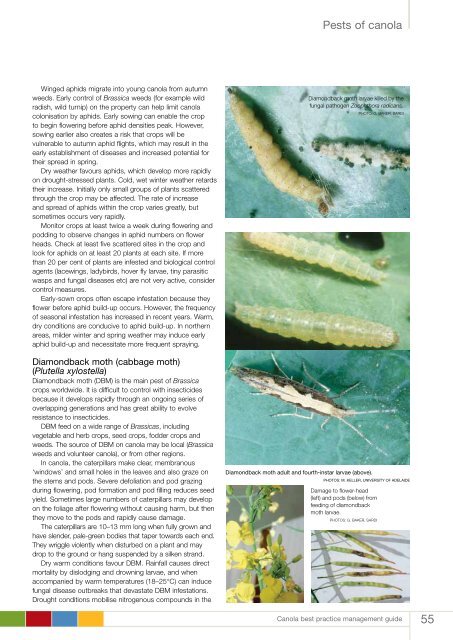best practice management guide for south-eastern Australia - Grains ...
best practice management guide for south-eastern Australia - Grains ...
best practice management guide for south-eastern Australia - Grains ...
Create successful ePaper yourself
Turn your PDF publications into a flip-book with our unique Google optimized e-Paper software.
Pests of canola<br />
Winged aphids migrate into young canola from autumn<br />
weeds. Early control of Brassica weeds (<strong>for</strong> example wild<br />
radish, wild turnip) on the property can help limit canola<br />
colonisation by aphids. Early sowing can enable the crop<br />
to begin flowering be<strong>for</strong>e aphid densities peak. However,<br />
sowing earlier also creates a risk that crops will be<br />
vulnerable to autumn aphid flights, which may result in the<br />
early establishment of diseases and increased potential <strong>for</strong><br />
their spread in spring.<br />
Dry weather favours aphids, which develop more rapidly<br />
on drought-stressed plants. Cold, wet winter weather retards<br />
their increase. Initially only small groups of plants scattered<br />
through the crop may be affected. The rate of increase<br />
and spread of aphids within the crop varies greatly, but<br />
sometimes occurs very rapidly.<br />
Monitor crops at least twice a week during flowering and<br />
podding to observe changes in aphid numbers on flower<br />
heads. Check at least five scattered sites in the crop and<br />
look <strong>for</strong> aphids on at least 20 plants at each site. If more<br />
than 20 per cent of plants are infested and biological control<br />
agents (lacewings, ladybirds, hover fly larvae, tiny parasitic<br />
wasps and fungal diseases etc) are not very active, consider<br />
control measures.<br />
Early-sown crops often escape infestation because they<br />
flower be<strong>for</strong>e aphid build-up occurs. However, the frequency<br />
of seasonal infestation has increased in recent years. Warm,<br />
dry conditions are conducive to aphid build-up. In northern<br />
areas, milder winter and spring weather may induce early<br />
aphid build-up and necessitate more frequent spraying.<br />
Diamondback moth (cabbage moth)<br />
(Plutella xylostella)<br />
Diamondback moth (DBM) is the main pest of Brassica<br />
crops worldwide. It is difficult to control with insecticides<br />
because it develops rapidly through an ongoing series of<br />
overlapping generations and has great ability to evolve<br />
resistance to insecticides.<br />
DBM feed on a wide range of Brassicas, including<br />
vegetable and herb crops, seed crops, fodder crops and<br />
weeds. The source of DBM on canola may be local (Brassica<br />
weeds and volunteer canola), or from other regions.<br />
In canola, the caterpillars make clear, membranous<br />
‘windows’ and small holes in the leaves and also graze on<br />
the stems and pods. Severe defoliation and pod grazing<br />
during flowering, pod <strong>for</strong>mation and pod filling reduces seed<br />
yield. Sometimes large numbers of caterpillars may develop<br />
on the foliage after flowering without causing harm, but then<br />
they move to the pods and rapidly cause damage.<br />
The caterpillars are 10–13 mm long when fully grown and<br />
have slender, pale-green bodies that taper towards each end.<br />
They wriggle violently when disturbed on a plant and may<br />
drop to the ground or hang suspended by a silken strand.<br />
Dry warm conditions favour DBM. Rainfall causes direct<br />
mortality by dislodging and drowning larvae, and when<br />
accompanied by warm temperatures (18–25°C) can induce<br />
fungal disease outbreaks that devastate DBM infestations.<br />
Drought conditions mobilise nitrogenous compounds in the<br />
Diamondback moth larvae killed by the<br />
fungal pathogen Zoophthora radicans.<br />
Diamondback moth adult and fourth-instar larvae (above).<br />
<br />
Photos: M. Keller, University of Adelaide<br />
Damage to flower-head<br />
(left) and pods (below) from<br />
feeding of diamondback<br />
moth larvae.<br />
Photos: G. Baker, SARDI<br />
Photo: G. Baker, SARDI<br />
Canola <strong>best</strong> <strong>practice</strong> <strong>management</strong> <strong>guide</strong><br />
55

















